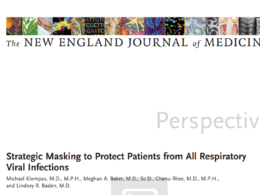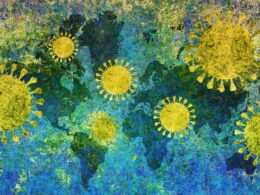Zoonotic diseases are the spillover of animal microbes into human populations
This is a republication of the article “One Health Approach Can Prevent the Next Pandemic”, with the title above.
World Bank
Axel van Trotsenburg and Mari Pangestu
OCTOBER 24, 2022
Site Editor:
Joaquim Cardoso MSc.
health transformation — institute for research, strategy and advisory
October 27, 2022
Summary:
- The number of emerging infectious disease (EID) outbreaks has grown to several hundred per year since 2000.
- Recent diseases such as SARS, avian influenza, Ebola — and the enormous health, economic, and societal impacts of COVID-19 — have not yet solicited global unity on the importance of preventing pandemics rather than responding to outbreaks as they emerge.
- What will it take for world leaders, countries, organizations, and communities to understand that prevention is better than cure?
- The World Bank’s latest flagship report, “Putting Pandemics Behind Us: Investing in One Health to Reduce Risks of Emerging Infectious Diseases,” is a clarion call for the universal adoption of an integrated approach to sustainably balance and optimize the health of people, animals, and ecosystems.
What will it take for world leaders, countries, organizations, and communities to understand that prevention is better than cure?
The World Bank’s latest flagship report, “Putting Pandemics Behind Us: Investing in One Health to Reduce Risks of Emerging Infectious Diseases,” is a clarion call for the universal adoption of an integrated approach to sustainably balance and optimize the health of people, animals, and ecosystems.

Risk Anywhere Is Risk Everywhere
Human activity is the main driving force behind new, emerging, and re-emerging diseases. Most pathogens that are infectious to humans are zoonotic — in other words, they cross over from animals to people.
As human societies extend their footprint and encroach on natural habitats, they disturb the ecological equilibrium, which results in the spillover of animal microbes into human populations.
Growing demand for animal-sourced foods has increased the number of livestock on farms, creating more opportunities for crossover of pathogens.
Every year, these diseases cause more than 1 billion human infections and 1 million deaths.
Every year, these diseases cause more than 1 billion human infections and 1 million deaths.
The pace of EID outbreaks has increased at an average annual rate of 6.7 percent from 1980 and is compounded by the global movement of goods and people, which enables local outbreaks to spread worldwide.
Diseases know no boundary; the next pandemic may already be on the horizon.
The pace of EID outbreaks has increased at an average annual rate of 6.7 percent from 1980 ….
… and is compounded by the global movement of goods and people, which enables local outbreaks to spread worldwide.

Confluence of Nature and Neglect
COVID-19 sparked a global health, economic, and societal emergency unlike any other in recent history.
It killed more than 6.3 million people as of June 2022, with true mortality being possibly three times higher and numbers continuing to rise.
The IMF projected the cumulative output loss from the pandemic through to 2024 to be about $13.8 trillion.
COVID-19 sparked a global health, economic, and societal emergency unlike any other in recent history. (1) It killed more than 6.3 million people as of June 2022, (2) the cumulative output loss from the pandemic through to 2024 to be about $13.8 trillion.
The business-as-usual approach to pandemics has been based on containment and control after a disease has emerged.
Not only is this short-sighted, but it is also costly and reactive.
Meanwhile, there is chronic underinvestment in disease prevention in many countries.
And while many of the benefits of prevention accrue at the national and global levels, the costs tend to be borne locally for interventions such as reducing forest fragmentation and deforestation, monitoring wildlife health, and enhancing the biosecurity of livestock farms.
The business-as-usual approach to pandemics has been based on containment and control after a disease has emerged. Not only is this short-sighted, but it is also costly and reactive
Meanwhile, there is chronic underinvestment in disease prevention in many countries.

Pandemic Prevention Is the Ultimate Investment for Humanity
Prevention is a global public good that requires an integrated, risk-based approach to prioritize spillover hot spots, ensure compliance with international health standards, and promote country ownership.
The good news is that these investments are highly effective: actions to prevent disease outbreaks carry an estimated rate of return of up to 86 percent, and most of these actions will result in significant co-benefits.
Prevention is a global public good that requires an integrated, risk-based approach to prioritize spillover hot spots, ensure compliance with international health standards, and promote country ownership.
Putting Pandemics Behind Us: Investing in One Health to Reduce Risks of Emerging Infectious Diseases explores the One Health holistic investment framework that will help governments, international organizations, and donors direct financial resources to prevent pandemics.
There is no one-size-fits-all solution and successful implementation will require a set of interventions that speaks to the national and local context.
There is no one-size-fits-all solution and successful implementation will require a set of interventions that speaks to the national and local context.
One Health is an integrated approach that supports a wide range of sustainable development objectives with significant co-benefits in areas such as agriculture, food production, and environmental protection.
For example, a One Health approach to prevention by reducing deforestation would generate ancillary benefits of $4.3 billion from lower carbon dioxide emissions.
…a One Health approach to prevention by reducing deforestation would generate ancillary benefits of $4.3 billion from lower carbon dioxide emissions.

One Health for Our Future
Many activities that drive EIDs (such as the mining and extractive industries) also contribute to the economic output of a country, as measured by its gross domestic product.
This makes it difficult to curtail such activities, particularly in high-risk regions that struggle with low growth and socio-economic disparity.
Successful implementation of One Health will require improved coordination, communication, and collaboration between sectors, reinforced by capacity building.
It requires a shift from largely vertical programs focused on specific diseases to those that can strengthen overall systems, including by engaging stakeholders beyond the health sector such as livestock keepers, park rangers, extractive industries, and communities responsible for environmental stewardship.
The World Bank report comes on the back of growing consensus on the critical importance of One Health and prevention, and increasing momentum at global, regional, and national levels, especially in the wake of COVID-19.
There is a strong economic case for One Health: the cost of prevention is moderate compared to the cost of managing and responding to pandemics.
The World Bank’s global estimate of prevention costs guided by One Health principles ranges from $10.3 billion to $11.5 billion per year, compared to the cost of managing pandemics which, according to the recent estimate by the G20 Joint Finance and Health Taskforce, amounts to about $30.1 billion per year.
… prevention costs guided by One Health principles ranges from $10.3 billion to $11.5 billion per year, …
… compared to the cost of managing pandemics which, … amounts to about $30.1 billion per year.
There has never been a better time to adopt One Health as an investment in humanity’s future.
The World Bank will continue to engage client governments, multilateral organizations, and other stakeholders to embed a One Health approach around the world.
ORIGINAL PUBLICATION
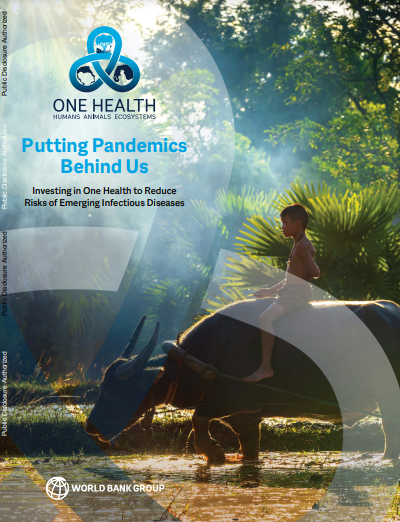
Executive summary
The next pandemic may already be on the horizon.
There is however nothing inevitable about the pace of outbreaks and emergence of infectious diseases, a growing number of which become
pandemics.
They are mainly the result of human activity, which is shaping the interactions among humans, animals, and the environment.
Seventy-five percent of emerging infectious diseases (EIDs), and almost all recent pandemics, are zoonoses — diseases having their origin in animals.
Seventy-five percent of emerging infectious diseases (EIDs), and almost all recent pandemics, are zoonoses — diseases having their origin in animals.
These diseases stem from increased contact between wildlife, livestock, and people, which allows microbes to ‘spill over’ from animals into human populations.
The most important reservoirs of pathogens with pandemic potential are wild animals (especially mammals, particularly bats, rodents, and primates), some birds (especially water fowl), and livestock (e.g., pigs, poultry, cattle, and camels).
The most important reservoirs of pathogens with pandemic potential are wild animals (especially mammals, particularly bats, rodents, and primates), some birds (especially water fowl), and livestock (e.g., pigs, poultry, cattle, and camels).
Effectively addressing the challenges posed by pandemics requires a departure from the old cycle of panic and neglect.
Even after experiencing this cycle for recent diseases such as SARS, avian
influenza, and Ebola and the enormous health, economic, and societal impacts caused by COVID-19, few leaders recognize the critical importance of pandemic prevention, which means stemming a local outbreak before it becomes a pandemic.
Even after experiencing this cycle for recent diseases such as SARS, avian
influenza, and Ebola and the enormous health, economic, and societal impacts caused by COVID-19, …
… few leaders recognize the critical importance of pandemic prevention, which means stemming a local outbreak before it becomes a pandemic.
The business-as-usual approach to pandemics has been based on containment and control after a disease has emerged. It relies primarily on reductionist approaches to vaccine and therapeutic development rather than on reducing the drivers of pandemic risk to prevent them before they emerge.
This has proven to be enormously expensive and insufficient to protect people from serious economic and social consequences of large outbreaks or pandemics.
Yet, prevention is almost always underfinanced relative to preparedness and especially to response.
The business-as-usual approach to pandemics has been based on containment and control after a disease has emerged.This has proven to be enormously expensive and insufficient to protect people from serious economic and social consequences of large outbreaks or pandemics.
Yet, prevention is almost always underfinanced relative to preparedness and especially to response.
Pandemic prevention is a global public good.
It is non-excludable (no country can prevent others from benefitting) and non-rival (one country benefitting does not limit the extent to which other
countries can benefit).
Therefore, One Health, which sustainably balances and optimizes the health of people, animals, and ecosystems, is the quintessential global public good, which may explain underinvestment as countries hope to benefit without contributing (the classic ‘free-rider’ problem).
Investment in pandemic prevention also has remained low because the benefits are largely invisible and uncounted, in the form of crises that do not occur.
Furthermore, some drivers of pandemics (e.g., forest exploitation, extractive industry, livestock farming, and urbanization) are closely tied to income generation and livelihoods, which can hinder necessary changes.
This report articulates an alternative approach that addresses pandemic risk at its source and is grounded in One Health strategies …
… of systems thinking, whole-of-society planning, and collaboration across disciplines at the human-animal-ecosystem interfaces as a central path to global health security.
The report highlights three main entry points to transition to this more effective approach.
1.First, timing.
Now is the opportune time to push for this transition, when the ravages of COVID-19 are still ongoing and there are high-level discussions about designing an international accord on pandemics and a new financing mechanism for pandemic prevention, preparedness, and response.
2.Second, the report highlights the relatively modest cost of prevention compared to crisis response.
Prevention guided by One Health principles is estimated to cost between approximately US$10.3 billion and US$11.5 billion per year.
This includes
- $2.1 billion per year to bring public veterinary services up to international standards,
- US$5 billion to improve farm biosecurity, and
- US$3.2-to-$4.4 billion to reduce deforestation in higher risk countries.
Prevention costs are less than 1 percent of the cost of responding to COVID-19 pandemic in one single year, 2020.
And the fact that prevention done right would de-risk investments in preparedness and reduce the need for subsequent response related costs.
Prevention costs are less than 1 percent of the cost of responding to COVID-19 pandemic in one single year, 2020.
3.Third, the report emphasizes the many co-benefits of investing in prevention and One Health for sustainable and human development.
These include reduction in CO2 emissions, climate adaptation, improved food safety and nutrition, reduced economic burden from animal diseases,
increased access to markets, and strengthening resilience of health systems by boosting awareness and multisectoral action.
For example, low- and middle-income countries could reap substantial
benefits for their agricultural sectors (specifically livestock), driven by reduced frequency and scale of costly disease control measures such as culling and expanded access to international and higher-margin markets for producers.
From a health security perspective, investments in prevention can improve the resilience of health systems, make investments in preparedness more effective, drastically reduce the need for response, and lessen the broader economic and social impacts of pandemics.
Such investments must be tailored to the country context, considering national risk profiles and circumstances.
One Health is an investment in humanity’s future. The co-benefits are high but so, too, is the cost of inaction.
To break the cycle of panic and neglect, within the broader PPR agenda, the report proposes a One Health Investment Framework for national, regional and global stakeholders to adopt.
This investment should be guided by five core principles of:
(i) adopting an integrated One Health multisectoral approach that aims to sustainably balance the health of people, animals, and ecosystems,
(ii) prioritizing prevention, a most overlooked component of health security,
(iii) complying with existing minimum standards that are relevant for One Health,
(iv) focusing on geographical locations with higher risks of spillover at the human-animal-ecosystem interfaces, and
(v) reducing risks of spillovers in forests (or wildlife habitat), farms (livestock), and sprawling urban areas.
One Health is a coordination-heavy agenda that requires strong champions, to mobilize finance as a shared responsibility, and a strong institutional arrangement backed by solid technical capacity
supporting its work.
Thus, to support countries, there is an important role for technical agencies and financial institutions to coordinate global, regional and local activities by the public sector (for public goods such as public health systems, public veterinary systems, ecosystem management and
protection, and surveillance data systems), the private sector (for livestock farmers, loggers, forest-based communities, and land developers) and the civil society.
A One Health investment framework needs to be adopted and implemented at the country level …
… based on alignment with each country’s prioritized national action plans, risk factors and vulnerabilities for EIDs, and existing resources and programs in areas for which there is overlap with the One Health agenda from public and private sources.
Doing so successfully would require:
(i) removing the obstacles to prevention;
(ii) financing prevention as a shared responsibility; and
(iii) ensuring country ownership and enabling institutional arrangements.
Investing in One Health based prevention is the best way forward to break the cycle of panic and neglect — once and for all.
If we fail to act now, we will be destined to become like Sisyphus, forever rolling a boulder uphill to manage the response to the next pandemics.
Infographic
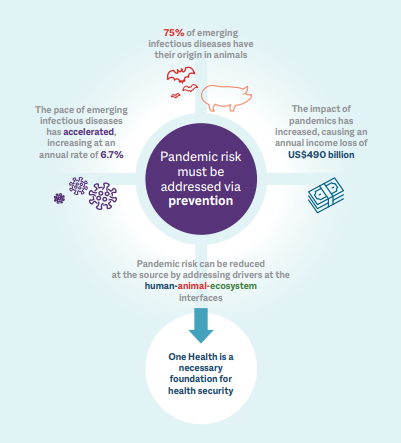
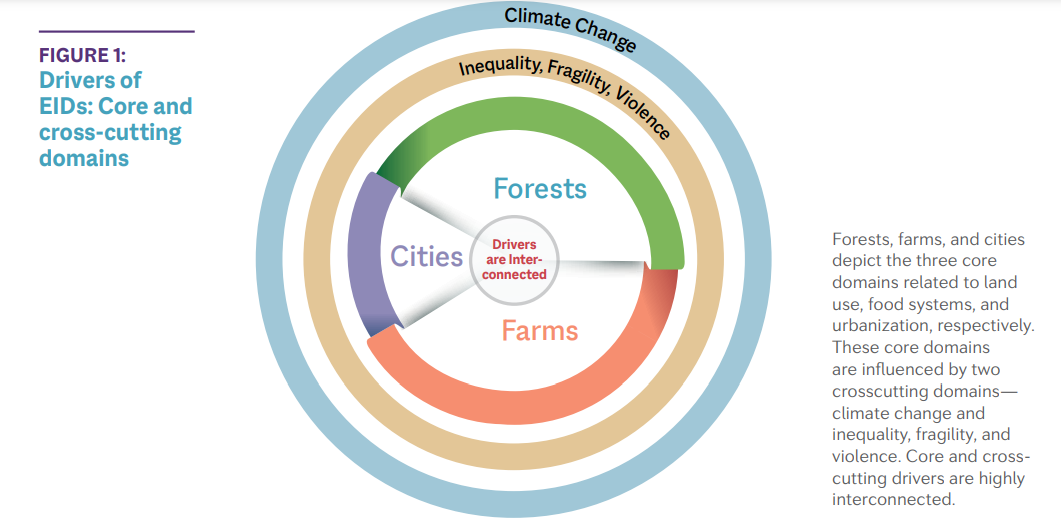
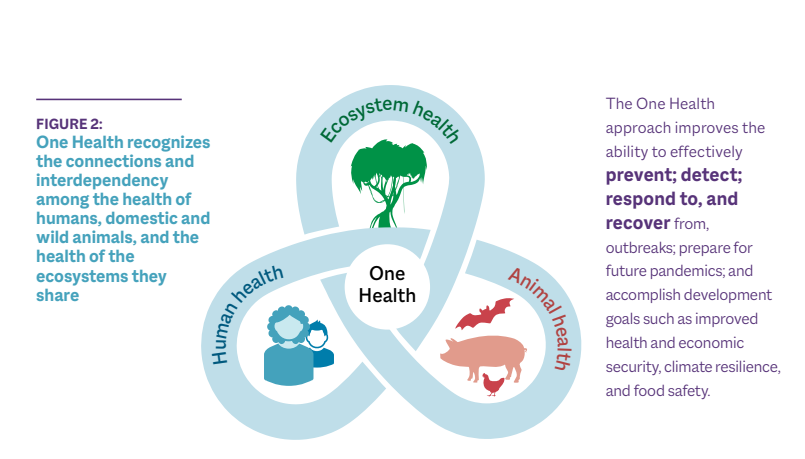
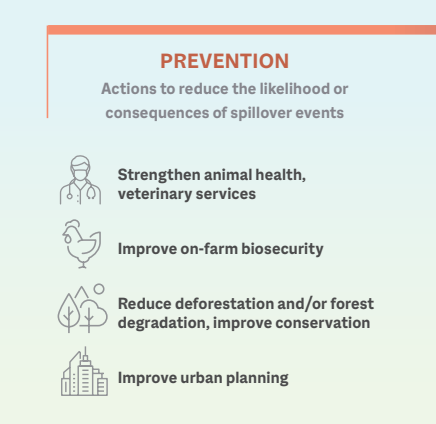
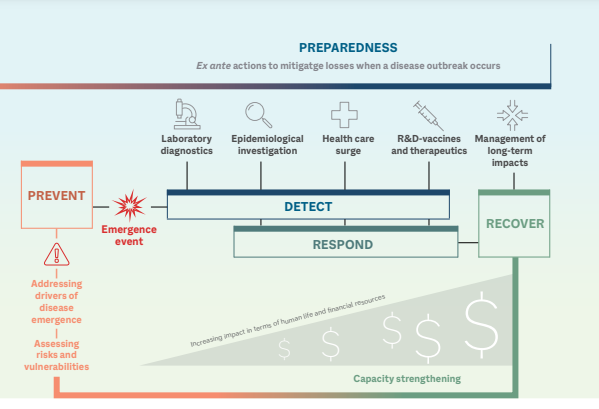
ACKNOWLEDGEMENTS
This report was written by a World Bank team co-led by Sulzhan Bali, Garo Batmanian and Franck Berthe, with contributions from Juan David Alduncin, Lucia Patricia Avila Bedregal, Marco Boggero, Luis Constantino, Felipe F. Dizon, Luis Diego Herrera Garcia, Kenan Karakulah, Catherine Machalaba, Simmy Martin Jain, Lisa Li Xi Lau, Samantha Elizabeth Power, Gayatri Rao Sanku, Geeta Sethi, Sarah Louise Shanks, Hina Khan Sherwani, Shweta Sinha, Yurie Tanimichi Hoberg, Eva Teekens, Aditya Babu Upadhyaula, Alex Vaval Pierre Charles, and Leonardo Viotti.
The team benefited from regular interactions with the One Health extended team of the World Bank including Mark E. Cackler, Ana Cristina Canales Gomez, Claire Chase, Gina Cosentino, Stephen Geoffrey Dorey, Sambe Duale, Lisa Farroway, Pierre Gerber, Artavazd Hakobyan, Hikuepi Katjiuongua, Anna Elisabeth Larsen, Sitaramachandra Machiraju, Daniel Mira-Salama, Tamer Samah Rabie, Yoshini Naomi Rupasinghe, Tahira Syed, Dipti Thapa, Mariela Huelden Varas, and Shiyong Wang.
The team is grateful for the peer review provided by Priya Basu, Richard Damania, Benoit Bosquet, and Magnus Lindelow.
The team is also grateful for the guidance and advice of the External Advisory Panel: Bernice Dahn (former Minister of Health, Republic of Liberia), Victor Dzau (President, National Academy of Medicine), Catherine Geslain-Laneelle (Director, Council of the European Union), Amanda Glassman (Vice-President, Center for Global Development), and Cecilia Mundaca Shah (Director, Global Health, United Nations Foundation).
The authors received helpful advice and comments from Gaël Giraud (Georgetown university), William B. Karesh, Noam Ross and Emma Mendelsohn (EcoHealth Alliance), Ben Oppenheim (Metabiota) and Richard Seifman.
In addition, the team is greatly indebted to colleagues from the Quadripartite alliance, Emily Tagliaro and Chadia Wannous (World Organisation for Animal Health), Katrin Taylor and Katinka DeBalogh (Food and Agriculture Organization of the UN), Margarita Meldon (United Nations Environment Programme) as well as Leen Meulenbergs and Stephane de la Rocque (World Health Organization) for their advice and helpful comments during this research.
Martien van Nieuwkoop and Juergen Voegele provided strategic guidance and substantive input throughout the preparation of the report, with support from Geeta Sethi, Mark E. Cackler, William Sutton, and Julian Lampietti.
Finally, Venkatakrishnan Ramachandran, Pawan Sachdeva, Michelle Rebosio, and Beaulah Noble provided impeccable administrative support for which the team is grateful.
The report was funded by the Federal Ministry for Economic Cooperation and Development (BMZ, Germany) as part of the World Bank’s FoodSystems2030 Trust Fund program on One Health.
The authors thank Karen Schneider for editing and Jay Groff for publication layout and design. They provided invaluable support for turning a manuscript into a finalized report
Originally published at https://www.worldbank.org.





